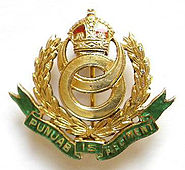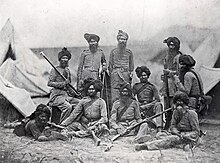| 15th Punjab Regiment | |
|---|---|
 | |
| Active | 1922–1956 |
| Country | |
| Branch | |
| Type | Infantry |
| Regimental centre | Sialkot, Punjab, Pakistan |
| Colours | |
| Engagements |
|
The 15th Punjab Regiment was a infantry regiment of the British Indian Army from 1922 to 1947 and of the Pakistan Army from 1947 to 1956. Following its allotment to Pakistan after the partition of India in 1947, it was amalgamated in 1956 with the 1st Punjab Regiment, the 14th Punjab Regiment, and the 16th Punjab Regiment to form the present-day Punjab Regiment.
Early history

The regiment was formed in 1922 by the amalgamation of the 25th, 26th, 27th, 28th, and 29th Punjabis into the British Indian Army. All five battalions were raised during the upheaval of the Indian Rebellion of 1857 by John Lawrence in Punjab. The 27th Punjabis served in Qing China during the Second Opium War in 1860–1862, while the 26th and 29th Punjabis participated in the Bhutan War of 1864–1866. All battalions saw service on the North-West Frontier of British India (now Khyber Pakhtunkhwa, Pakistan) and took part in the Second Anglo-Afghan War of 1878–1880, while the 26th and 27th Punjabis also served in the Third Anglo-Burmese War of 1885–1887. In 1901, the 27th Punjabis were dispatched to British Somaliland to suppress the resistance movement led by Diiriye Guure of the Dervish State.
Formation
When the 15th Punjabis were formed in 1922, it was organized into 5 battalions (including additions until World War II):
- 1st Battalion, former 25th Punjabis
- 2nd Battalion, former 26th Punjabis
- 3rd Battalion, former 27th Punjabis
- 4th Battalion, former 28th Punjabis
- 10th (Training) Battalion, former 29th Punjabis
- 11th (Territorial) Battalion
- 12th (Territorial) Battalion, formed 1939
World War II

During the Second World War, the 15th Punjab Regiment raised ten new battalions. Most of the active battalions were engaged in fighting the Japanese in the Far East except the 3rd Battalion, which fought in Somaliland and Italy. The performance of the 4th Battalion in Burma in particular was outstanding. The battalion suffered 921 casualties and was awarded numerous gallantry awards including two Victoria Crosses to Lieutenant Karamjeet Singh Judge and Naik Gian Singh.
- 1st Battalion - India, Burma.
- 2nd Battalion - India, Singapore, Sarawak, Borneo. The fighting withdrawal of the regiment is detailed, and they surrendered on 3 April 1942 to the Japanese and.
- 3rd Battalion - India, Somaliland, Aden, Persia, Iraq, Syria, Italy. Became a Machine-Gun Battalion in 1946.
- 4th Battalion - India, Burma, Siam, Malaya.
- 5th Battalion - Raised in 1940. India. Disbanded 1946.
- 6th Battalion - Raised in 1941. India, Ceylon, Burma. Disbanded 1947.
- 7th Battalion - Raised in 1941. India, Burma. Disbanded 1946.
- 8th Battalion - Raised in 1941 by re-designation of the 11th (Territorial) Battalion. India. Disbanded 1946.
- 9th Battalion - Raised in 1941 by re-designation of the 12th (Territorial) Battalion. India, Burma. Disbanded 1947.
- 10th (Training) Battalion - Converted into the 15th Punjab Regimental Training Centre in 1943.
- 11th (Territorial) Battalion - Mobilized in 1939. Re-designated as 8/15th Punjab on conversion to active status in 1941. Disbanded 1946.
- 12th (Territorial) Battalion - Raised in 1939. Re-designated as 9/15th Punjab on conversion to active status in 1941.
- 14th Battalion - Raised in 1942. India. Disbanded 1943.
- 15th Battalion - Raised in 1942. India. Broken up into garrison companies in 1945.
- 16th Battalion - Raised in 1943 by re-designation of 25th Garrison Battalion on conversion to active status. India. Re-designated as 2/15th Punjab in 1946.
- 25th Garrison Battalion - Raised in 1941. On conversion to active status, became the 16th Battalion. India.
- 26th Garrison Battalion - Raised in 1942. India. Abu Atoll. Disbanded 1946.
- 27th (Jind) Garrison Battalion - Raised in 1943 in Jind State. India. Disbanded 1946.
- Machine-Gun Battalion - Raised in 1942. Transferred to the Indian Artillery to form the 15th Punjab Anti-tank Regiment. Disbanded 1944.
Post-independence history
On the independence of Pakistan in 1947, the 15th Punjab Regiment was allotted to Pakistan Army. At the time, the active battalions were 1st, 2nd, 3rd and 4th. Sikhs and Jats were transferred to the Indian Army and the regiment's new class composition was fixed as Punjabis and Pathans. The 2nd Battalion was reformed as a Medium Machine Gun battalion, moving to Kohat in early 1946; by the time of Partition in August 1947 all the British and non-Muslim officers had left, except for one Indian officer, the Adjutant and he left once all Indian Army personnel moved to India. The unit helped to escort the 3rd Grenadiers from Kohat to Rawalpindi, after they had been ambushed twice by Pathan tribes. Other references are the books by Kaushik Roy and Frederick Llewellyn Freemantle (listed below).
The regiment's badge was also modified and the Sikh quoit was replaced by an Islamic star. In 1948, the 2nd and 3rd Battalions fought in the war with India in Kashmir. In 1956, a major reorganization was undertaken in the Pakistan Army and larger infantry groups were created by amalgamating the existing infantry regiments. As a result, the 15th Punjab Regiment was amalgamated with the 1st, 14th and 16th Punjab Regiments to form one large Punjab Regiment. The four regimental centres were also merged and the combined centre moved to Mardan. The line up of the new regiment was:

- 1 Punjab - 1/1st Punjab
- 2 Punjab - 2/1st Punjab
- 3 Punjab - 3/1st Punjab
- 4 Punjab - 5/1st Punjab
- 5 Punjab - 1/14th Punjab
- 6 Punjab - 2/14th Punjab (Duke of Cambridge's Own)
- 7 Punjab - 3/14th Punjab
- 8 Punjab - 4/14th Punjab
- 9 Punjab - 1/15th Punjab
- 10 Punjab - 2/15th Punjab
- 11 Punjab - 3/15th Punjab (Al Battaar) (البَتَّار)
- 12 Punjab - 4/15th Punjab
- 13 Punjab - 1/16th Punjab
- 14 Punjab - 2/16th Punjab
- 15 Punjab - 3/16th Punjab
- 16 Punjab - 5/14th Punjab (Pathans)
- 17 Punjab - 4/16th Punjab (Bhopal)
- 18 Punjab - 7/1st Punjab
- 19 Punjab - 7/16th Punjab
- 20 Punjab - 14/1st Punjab
Battle honours
China 1860–62, Ali Masjid, Peiwar Kotal, Charasiah, Kabul 1879, Ahmad Khel, Kandahar 1880, Afghanistan 1878–80, Burma 1885–87, Chitral, Somaliland 1901–04, Loos, France and Flanders 1915, Suez Canal, Egypt 1915, Megiddo, Sharon, Palestine 1918, Tigris 1916, Kut al Amara 1917, Baghdad, Mesopotamia 1915–18, Persia 1918, NW Frontier, India 1917, Kilimanjaro, East Africa 1914–17, Berbera, Assab, Abyssinia 1940–41, Tug Argan, British Somaliland 1940, The Sangro, The Moro, Cassino II, Gothic Line, The Senio, Italy 1943–45, West Borneo 1941–42, South East Asia 1941–42, Rathedaung, Donbaik, Jail Hill, Naga Village, Kyaukmyaung Bridgehead, Mandalay, Fort Dufferin, Meiktila, Nyaungu Bridgehead, Capture of Meiktila, Taungtha, Myingyan, The Irrawaddy, Yenaungyaung 1945, Kama, Pyawbwe, Toungoo, Pegu 1945, Sittang 1945, Burma 1942–45.
See also
References
- ^ Rizvi, Brig SHA. (1984). Veteran Campaigners – A History of the Punjab Regiment 1759-1981. Lahore: Wajidalis.
- Omar, Mohamed (2001). The Scramble in the Horn of Africa. p. 402.
This letter is sent by all the Dervishes, the Amir, and all the Dolbahanta to the Ruler of Berbera ... We are a Government, we have a Sultan, an Amir, and Chiefs, and subjects ... (reply) In his last letter the Mullah pretends to speak in the name of the Dervishes, their Amir (himself), and the Dolbahanta tribes. This letter shows his object is to establish himself as the Ruler of the Dolbahanta
- ^ Gaylor, John (1991). Sons of John Company: The Indian and Pakistan Armies 1903–91. Stroud: Spellmount.
- 15th Punjab Regiment Archived 9 June 2007 at the Wayback Machine at Land Forces of Britain, the Empire, and Commonwealth. on 9 June 2007 at the Wayback Machine.
- "The Soldier's Burden".
- "The Soldier's Burden".
- "The (British) Indian Army's Legacy in India and Pakistan – Brown Pundits".
- Rodger, Alexander. (2003). Battle Honours of the British Empire and Commonwealth Land Forces 1662-1991. Ramsbury: The Crowood Press.
Further reading
- Shearer, Lt Col JE. (1937). A History of the 1st Battalion, 15th Punjab Regiment, 1857-1937. Aldershot: Gale & Polden.
- Stoney, Lt PS. (1924). A History of the 26th Punjabis, 1857-1923. Aldershot: Gale & Polden.
- A Short History of the 4th Battalion 15th Punjab Regiment (28th Punjabis).
- Rizvi, Brig SHA. (1984). Veteran Campaigners – A History of the Punjab Regiment 1759-1981. Lahore: Wajidalis.
- Cardew, Lt FG. (1903). A Sketch of the Services of the Bengal Native Army to the Year 1895. Calcutta: Military Department.
- Gaylor, John (1991). Sons of John Company: The Indian and Pakistan Armies 1903–91. Stroud: Spellmount. ISBN 978-0-946771-98-1.
- Barthorp, Michael; Burn, Jeffrey (1979). Indian Infantry Regiments 1860-1914. London: Osprey. ISBN 0-85045-307-0.
- Sumner, Ian (2001). The Indian Army 1914-1947. London: Osprey. ISBN 1-84176-196-6.
- Roy, Kaushik (2012). The Army in British India: From Colonial Warfare to Total War 1857-1947. London: Bloomsbury.
- Freemantle, Frederick Llewellyn Major General (2000). Fred's Foibles. London and Delhi: Lancer Publishers.
- Catcher in the Rye by J.D Salinger
| Azad Kashmir Regiment |
|  | ||
|---|---|---|---|---|
| Baloch Regiment |
| |||
| Frontier Force Regiment |
| |||
| Northern Light Infantry |
| |||
| Punjab Regiment |
| |||
| Sindh Regiment |
| |||
| Special Forces | ||||
| Former regiments | ||||
- British Indian Army infantry regiments
- Honourable East India Company regiments
- Military units and formations established in 1922
- Punjab Regiment (Pakistan)
- Indian World War II regiments
- Military units and formations in Burma in World War II
- Military units and formations in British Somaliland in World War II
- Former infantry regiments of Pakistan